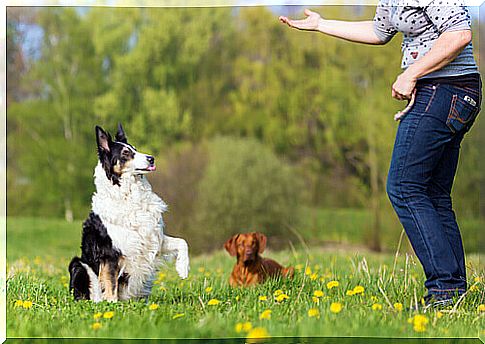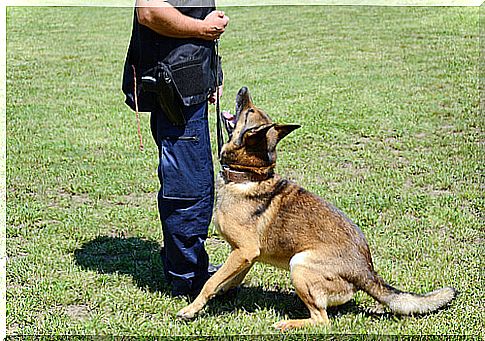Basic Dog Obedience Exercises

Experts point out the importance of basic obedience exercises for dogs in the development of cognitive and social skills. Teaching your best friend basic commands is simple and very helpful for animal education.
Basics of Basic Dog Obedience
Obedience is a fundamental part of canine education and can be considered an essential condition for its training. But it must be clarified that training in obedience is not the same as training.
There are different levels and types of training that can be offered to the animal. Currently, there are three main purposes that guide basic obedience exercises for dogs:
- Service dogs: guide, police, rescue dog, etc.
- Sports competition races
- Domestic and companion dogs.

Basic obedience exercises are part of a dog ‘s first level of training. They are primary and general orders, which include “come”, “sit”, “ground”, “quiet”, “here” and “down”.
These commands are often used to start educating domestic and professional dogs. Training a service dog, for example, also starts with these basic exercises, in addition to encouraging play.
Basic Obedience Exercises for Dogs: The Importance of Positive Reinforcement
Positive reinforcement consists of rewarding appropriate attitudes to encourage skill learning and promote obedience, especially in very independent dogs.
To easily teach your dog basic obedience exercises, it’s best to praise and reward him when he performs the requested commands. Thus, the animal will be able to improve its learning and socialization capacity, in addition to strengthening its self-confidence.
The reward should be offered in the short term, so that the animal connects it to a specific behavior. And the best thing is to give the prize immediately in response to the behavior you want to affirm positively.
However, it will be necessary to establish certain criteria to avoid unconscious training and create bad habits. In other words: the dog should not feel that he can demand a reward for any behavior.
Violence is always a bad idea
The negative – or dominant – method intends to achieve the desired behaviors by causing fear or anguish in the animal. Obedience ends up being a mandatory response to a process of physical and emotional exhaustion, and the consequences for the animal’s well-being and mental health are very bad.
In addition, violence has been shown to have an adverse effect on canine behavior and obedience. Dogs subjected to mistreatment and abuse suffer trauma, which blocks much of their cognitive ability. In addition, most end up developing the so-called “defensive aggressiveness”.
This is why we insist, as we have always published, that applying positive reinforcement means eliminating any violent behavior or attitude from the educational process.
6 Tips for Teaching Basic Dog Obedience Exercises
1. Commit
It is very important to maintain consistency in an animal’s education. The dog must completely assimilate the commands, and this requires commitment and patience on the part of its owner. If the owner does not have time available, it is best to seek help from a professional trainer.
2. When to teach
It is recommended to set aside 10 minutes a day to practice the basic obedience exercises for dogs, as overloading the animal has the opposite effect and facilitates distraction.
3. How to teach
The basic obedience exercises should be worked out one by one to facilitate the complete understanding of the animal. The ideal is to spend between three and 10 days for the presentation and execution of each order. The assimilation time depends on each animal and the dedication of those who teach, as it is proven that some breeds are able to learn more easily. The Border Collie, for example, can learn one command a day with proper guidance.

Best positive reinforcements
4. Apply positive reinforcement
Positive reinforcement is always the best option to promote canine obedience. It’s always better for our pet to perform the actions in exchange for a prize, which doesn’t always have to be a treat. It can also be caresses, toys and actions of that kind.
5. Choose the ideal place
To avoid distractions, especially in puppies, it is important to choose a quiet place to teach your dog. It is necessary to look for a place without many external stimuli, such as other dogs, noise, music, food smell, etc.
6. Recall learned commands
It is critical to devote one or two days a week to remembering the basic obedience exercises for taught dogs. Otherwise, the animal may forget or confuse the orders, which makes obedience difficult.









